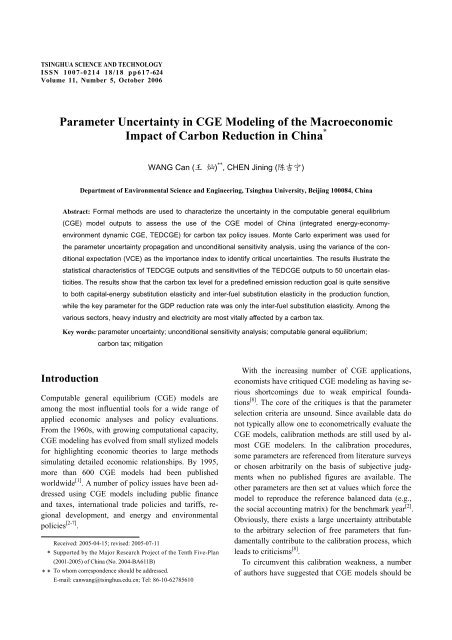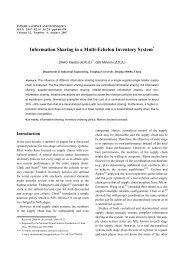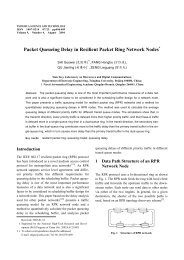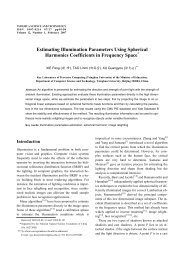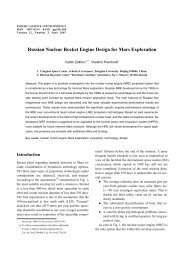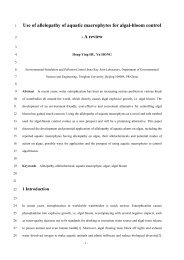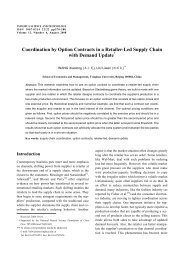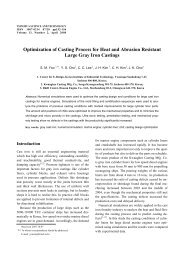Parameter Uncertainty in CGE Modeling of the Macroeconomic Impact
Parameter Uncertainty in CGE Modeling of the Macroeconomic Impact
Parameter Uncertainty in CGE Modeling of the Macroeconomic Impact
Create successful ePaper yourself
Turn your PDF publications into a flip-book with our unique Google optimized e-Paper software.
TSINGHUA SCIENCE AND TECHNOLOGY<br />
ISSN 1007-0214 18/18 pp617-624<br />
Volume 11, Number 5, October 2006<br />
<strong>Parameter</strong> <strong>Uncerta<strong>in</strong>ty</strong> <strong>in</strong> <strong>CGE</strong> Model<strong>in</strong>g <strong>of</strong> <strong>the</strong> <strong>Macroeconomic</strong><br />
<strong>Impact</strong> <strong>of</strong> Carbon Reduction <strong>in</strong> Ch<strong>in</strong>a *<br />
WANG Can (王 灿) ** , CHEN J<strong>in</strong><strong>in</strong>g (陈吉宁)<br />
Department <strong>of</strong> Environmental Science and Eng<strong>in</strong>eer<strong>in</strong>g, Ts<strong>in</strong>ghua University, Beij<strong>in</strong>g 100084, Ch<strong>in</strong>a<br />
Abstract: Formal methods are used to characterize <strong>the</strong> uncerta<strong>in</strong>ty <strong>in</strong> <strong>the</strong> computable general equilibrium<br />
(<strong>CGE</strong>) model outputs to assess <strong>the</strong> use <strong>of</strong> <strong>the</strong> <strong>CGE</strong> model <strong>of</strong> Ch<strong>in</strong>a (<strong>in</strong>tegrated energy-economy-<br />
environment dynamic <strong>CGE</strong>, TED<strong>CGE</strong>) for carbon tax policy issues. Monte Carlo experiment was used for<br />
<strong>the</strong> parameter uncerta<strong>in</strong>ty propagation and unconditional sensitivity analysis, us<strong>in</strong>g <strong>the</strong> variance <strong>of</strong> <strong>the</strong> con-<br />
ditional expectation (VCE) as <strong>the</strong> importance <strong>in</strong>dex to identify critical uncerta<strong>in</strong>ties. The results illustrate <strong>the</strong><br />
statistical characteristics <strong>of</strong> TED<strong>CGE</strong> outputs and sensitivities <strong>of</strong> <strong>the</strong> TED<strong>CGE</strong> outputs to 50 uncerta<strong>in</strong> elas-<br />
ticities. The results show that <strong>the</strong> carbon tax level for a predef<strong>in</strong>ed emission reduction goal is quite sensitive<br />
to both capital-energy substitution elasticity and <strong>in</strong>ter-fuel substitution elasticity <strong>in</strong> <strong>the</strong> production function,<br />
while <strong>the</strong> key parameter for <strong>the</strong> GDP reduction rate was only <strong>the</strong> <strong>in</strong>ter-fuel substitution elasticity. Among <strong>the</strong><br />
various sectors, heavy <strong>in</strong>dustry and electricity are most vitally affected by a carbon tax.<br />
Key words: parameter uncerta<strong>in</strong>ty; unconditional sensitivity analysis; computable general equilibrium;<br />
Introduction<br />
carbon tax; mitigation<br />
Computable general equilibrium (<strong>CGE</strong>) models are<br />
among <strong>the</strong> most <strong>in</strong>fluential tools for a wide range <strong>of</strong><br />
applied economic analyses and policy evaluations.<br />
From <strong>the</strong> 1960s, with grow<strong>in</strong>g computational capacity,<br />
<strong>CGE</strong> model<strong>in</strong>g has evolved from small stylized models<br />
for highlight<strong>in</strong>g economic <strong>the</strong>ories to large methods<br />
simulat<strong>in</strong>g detailed economic relationships. By 1995,<br />
more than 600 <strong>CGE</strong> models had been published<br />
worldwide [1] . A number <strong>of</strong> policy issues have been addressed<br />
us<strong>in</strong>g <strong>CGE</strong> models <strong>in</strong>clud<strong>in</strong>g public f<strong>in</strong>ance<br />
and taxes, <strong>in</strong>ternational trade policies and tariffs, regional<br />
development, and energy and environmental<br />
policies [2-7] .<br />
*<br />
**<br />
Received: 2005-04-15; revised: 2005-07-11<br />
Supported by <strong>the</strong> Major Research Project <strong>of</strong> <strong>the</strong> Tenth Five-Plan<br />
(2001-2005) <strong>of</strong> Ch<strong>in</strong>a (No. 2004-BA611B)<br />
To whom correspondence should be addressed.<br />
E-mail: canwang@ts<strong>in</strong>ghua.edu.cn; Tel: 86-10-62785610<br />
With <strong>the</strong> <strong>in</strong>creas<strong>in</strong>g number <strong>of</strong> <strong>CGE</strong> applications,<br />
economists have critiqued <strong>CGE</strong> model<strong>in</strong>g as hav<strong>in</strong>g serious<br />
shortcom<strong>in</strong>gs due to weak empirical foundations<br />
[8] . The core <strong>of</strong> <strong>the</strong> critiques is that <strong>the</strong> parameter<br />
selection criteria are unsound. S<strong>in</strong>ce available data do<br />
not typically allow one to econometrically evaluate <strong>the</strong><br />
<strong>CGE</strong> models, calibration methods are still used by almost<br />
<strong>CGE</strong> modelers. In <strong>the</strong> calibration procedures,<br />
some parameters are referenced from literature surveys<br />
or chosen arbitrarily on <strong>the</strong> basis <strong>of</strong> subjective judgments<br />
when no published figures are available. The<br />
o<strong>the</strong>r parameters are <strong>the</strong>n set at values which force <strong>the</strong><br />
model to reproduce <strong>the</strong> reference balanced data (e.g.,<br />
<strong>the</strong> social account<strong>in</strong>g matrix) for <strong>the</strong> benchmark year [2] .<br />
Obviously, <strong>the</strong>re exists a large uncerta<strong>in</strong>ty attributable<br />
to <strong>the</strong> arbitrary selection <strong>of</strong> free parameters that fundamentally<br />
contribute to <strong>the</strong> calibration process, which<br />
leads to criticisms [8] .<br />
To circumvent this calibration weakness, a number<br />
<strong>of</strong> authors have suggested that <strong>CGE</strong> models should be
618<br />
tested for robustness by implement<strong>in</strong>g sensitivity<br />
analyses around <strong>the</strong> elasticity mean values [9-14] . However,<br />
<strong>in</strong> practice most analyses use limited sensitivity<br />
analyses, with changes <strong>in</strong> a few key elasticities to exam<strong>in</strong>e<br />
<strong>the</strong> sensitivity <strong>of</strong> <strong>the</strong> results. This procedure has<br />
no way <strong>of</strong> ensur<strong>in</strong>g that <strong>the</strong> chosen elasticities are <strong>the</strong><br />
important ones, and its role is also limited by <strong>the</strong> discretionary<br />
character <strong>of</strong> <strong>the</strong> values selected. Few <strong>of</strong> <strong>the</strong><br />
exist<strong>in</strong>g studies ei<strong>the</strong>r systematically explore <strong>the</strong> parameter<br />
uncerta<strong>in</strong>ty propagation or exam<strong>in</strong>e <strong>the</strong> contribution<br />
<strong>of</strong> <strong>the</strong> various parameters to <strong>the</strong> uncerta<strong>in</strong>ty due<br />
to <strong>the</strong> expensive comput<strong>in</strong>g costs. Harrison et al. [11]<br />
and Alber et al. [13] conducted unconditional sensitivity<br />
analyses, but <strong>the</strong>y focused only on some <strong>of</strong> <strong>the</strong> elasticities<br />
and failed to describe <strong>the</strong> <strong>CGE</strong> output distributional<br />
<strong>in</strong>formation.<br />
The purpose <strong>of</strong> this paper is to study <strong>the</strong> problem <strong>of</strong><br />
measur<strong>in</strong>g <strong>the</strong> uncerta<strong>in</strong>ty <strong>of</strong> <strong>CGE</strong> model simulations<br />
associated with parameter uncerta<strong>in</strong>ty us<strong>in</strong>g <strong>the</strong> macroeconomic<br />
impacts <strong>of</strong> a carbon tax <strong>in</strong> Ch<strong>in</strong>a as <strong>the</strong><br />
policy question for <strong>the</strong> simulations. The study used<br />
Monte Carlo experiments for <strong>the</strong> parameter uncerta<strong>in</strong>ty<br />
propagation and employed an unconditional systematic<br />
sensitivity analysis procedure to identify critically sensitive<br />
elasticities. The analytical process adopted <strong>in</strong> this<br />
paper is extensively used <strong>in</strong> model evaluations [15] .<br />
1 <strong>CGE</strong> Model<br />
The model developed here, <strong>in</strong>tegrated energyeconomy-environment<br />
dynamic <strong>CGE</strong> (TED<strong>CGE</strong>), is a<br />
time recursive dynamic general equilibrium model,<br />
which has been presented <strong>in</strong> detail [16] . S<strong>in</strong>ce <strong>the</strong> dynamic<br />
mechanism has little impact on <strong>the</strong> elasticities’<br />
<strong>in</strong>fluence on <strong>the</strong> <strong>CGE</strong> output and it is very time consum<strong>in</strong>g<br />
compared with <strong>the</strong> static <strong>CGE</strong> model, <strong>the</strong> static<br />
version <strong>of</strong> <strong>the</strong> model was used to exam<strong>in</strong>e <strong>the</strong> elasticities’<br />
uncerta<strong>in</strong>ties.<br />
The TED<strong>CGE</strong> model provides a description <strong>of</strong> <strong>the</strong><br />
Ch<strong>in</strong>a economy <strong>of</strong> 1997, <strong>the</strong> latest year for which <strong>the</strong><br />
Ch<strong>in</strong>a <strong>in</strong>put/output is available. The model identifies<br />
10 production sectors (agriculture, heavy <strong>in</strong>dustry,<br />
light <strong>in</strong>dustry, transportation, construction, service<br />
electricity, coal, oil, and natural gas, which are numbered<br />
as 1 to 10, respectively), 10 consumption goods,<br />
and 2 household groups dist<strong>in</strong>guished by rural and urban<br />
residents. The model operates by simulat<strong>in</strong>g <strong>the</strong><br />
operation <strong>of</strong> markets for factors, products, and foreign<br />
Ts<strong>in</strong>ghua Science and Technology, October 2006, 11(5): 617-624<br />
exchange. The model is highly nonl<strong>in</strong>ear, with equations<br />
specify<strong>in</strong>g supply and demand behavior across all<br />
markets. The model pays particular attention to model<strong>in</strong>g<br />
<strong>the</strong> energy sector and its l<strong>in</strong>kages to <strong>the</strong> rest <strong>of</strong> <strong>the</strong><br />
economy. The energy use is disaggregated <strong>in</strong>to coal, oil,<br />
natural gas, and electricity <strong>in</strong> <strong>the</strong> model. Along with<br />
capital, labour, and <strong>in</strong>termediate <strong>in</strong>puts, <strong>the</strong> four energy<br />
<strong>in</strong>puts are regarded as <strong>the</strong> basic <strong>in</strong>puts <strong>in</strong>to <strong>the</strong> production<br />
function.<br />
The carbon tax revenue from <strong>the</strong> sectoral energy<br />
consumption is described by<br />
E<br />
10 10<br />
∑∑<br />
RC ( t) = tc ⋅ε⋅(1−fc ) ⋅θ ⋅VE ( t)<br />
⋅ο<br />
i= 1 j=<br />
7<br />
h= 1 j=<br />
7<br />
j j j ji j<br />
(1)<br />
The carbon tax revenue from residential energy use is<br />
described by<br />
2 10<br />
RC C ( t) = ∑∑ tc ⋅εj ⋅θj ⋅CI hj( t)<br />
⋅οj<br />
(2)<br />
VEji is <strong>the</strong> monetary consumption (RMB) <strong>of</strong> fuel j by<br />
sector i, CIhj is <strong>the</strong> residential consumption (RMB) <strong>of</strong><br />
fuel j by household h, tc denotes <strong>the</strong> carbon tax rate <strong>in</strong><br />
terms <strong>of</strong> RMB/t, εj denotes <strong>the</strong> CO2 emission coefficient<br />
<strong>of</strong> fuel j with <strong>the</strong> unit <strong>of</strong> t/TJ, fcj is <strong>the</strong> carbon<br />
fixed rate <strong>of</strong> fuel j, θj is <strong>the</strong> conversion factor <strong>of</strong> fuel j<br />
from a nom<strong>in</strong>al output value to a physical term with <strong>the</strong><br />
unit <strong>of</strong> TJ/RMB, and οj is <strong>the</strong> oxidation rate <strong>of</strong> fuel j.<br />
The CO2 emissions are calculated for each sector by<br />
means <strong>of</strong> <strong>the</strong> sectoral fuel consumption and <strong>the</strong> correspond<strong>in</strong>g<br />
emission coefficient. S<strong>in</strong>ce <strong>the</strong> fuel consumption<br />
is <strong>in</strong> terms <strong>of</strong> <strong>the</strong> correspond<strong>in</strong>g nom<strong>in</strong>al output<br />
ra<strong>the</strong>r than directly as <strong>the</strong> physical units <strong>in</strong> <strong>the</strong> model,<br />
<strong>the</strong> sectoral real fuel consumption is first translated<br />
<strong>in</strong>to physical terms, us<strong>in</strong>g a fuel-specific technical<br />
conversion factor, and <strong>the</strong>n fur<strong>the</strong>r converted <strong>in</strong>to CO2<br />
based on <strong>the</strong> fuel-specific emission coefficient. The<br />
fuel used by different sectors is assumed to have <strong>the</strong><br />
same quality, imply<strong>in</strong>g equivalent emission factors, <strong>in</strong><br />
terms <strong>of</strong> tons <strong>of</strong> CO2 per unit <strong>of</strong> fuel consumption, for<br />
a fuel used <strong>in</strong> production, households, or government.<br />
A carbon tax is <strong>in</strong>corporated <strong>in</strong>to <strong>the</strong> model as a means<br />
<strong>of</strong> achiev<strong>in</strong>g an assumed carbon reduction target. The<br />
tax applies to <strong>the</strong> consumption <strong>of</strong> primary fuels only;<br />
that is, <strong>the</strong> energy sectors only pay <strong>the</strong> carbon tax on<br />
<strong>the</strong>ir own use <strong>of</strong> fuels. The carbon tax revenue is recycled<br />
to <strong>the</strong> economy <strong>in</strong> several alternative ways, ensur<strong>in</strong>g<br />
that <strong>the</strong> total government revenue is neutral to <strong>the</strong><br />
carbon tax.
WANG Can (王 灿) et al:<strong>Parameter</strong> <strong>Uncerta<strong>in</strong>ty</strong> <strong>in</strong> <strong>CGE</strong> Model<strong>in</strong>g <strong>of</strong>… 619<br />
As with most <strong>CGE</strong> models, <strong>the</strong> substitution elasticities<br />
and <strong>the</strong> transformation elasticities are <strong>in</strong>corporated<br />
through constant elasticity <strong>of</strong> substitution (CES)<br />
and constant elasticity <strong>of</strong> transformation (CET) functions<br />
<strong>in</strong>to <strong>the</strong> production and import/export decisionmak<strong>in</strong>g<br />
procedure <strong>in</strong> TED<strong>CGE</strong>. Both <strong>the</strong>se functions<br />
have <strong>the</strong> same general form:<br />
( ( ) ) 1<br />
ρ<br />
−<br />
1 1<br />
2<br />
ρ<br />
Y = φ δ ⋅ X + −δ ⋅ X ρ (3)<br />
where Y is <strong>the</strong> aggregate composite <strong>of</strong> X1 and X2, φ is<br />
<strong>the</strong> efficiency parameter, δ is <strong>the</strong> share parameter, and<br />
ρ is <strong>the</strong> substitution parameter. The substitution parameter<br />
is a function <strong>of</strong> <strong>the</strong> substitution or transformation<br />
elasticity, ε, def<strong>in</strong>ed as ρ = ( ε −1) ε if Eq. (3) is a<br />
CES and as ρ = ( ε + 1) ε if Eq. (3) is a CET. The full<br />
model <strong>in</strong>cludes, as exogenous parameters, four substitution<br />
elasticities (three <strong>in</strong> <strong>the</strong> production function and<br />
one <strong>in</strong> <strong>the</strong> import demand function) and one transformation<br />
elasticity (<strong>in</strong> <strong>the</strong> export supply function) for<br />
each <strong>of</strong> <strong>the</strong> ten sectors, for a total <strong>of</strong> 50 elasticities to<br />
be def<strong>in</strong>ed <strong>in</strong> <strong>the</strong> calibration process.<br />
2 <strong>Uncerta<strong>in</strong>ty</strong> Analysis Method<br />
Monte Carlo simulations and unconditional systematic<br />
sensitivity analysis were used to determ<strong>in</strong>e <strong>the</strong> uncerta<strong>in</strong>ty<br />
<strong>in</strong> <strong>the</strong> <strong>CGE</strong> model results given <strong>the</strong> parameter<br />
uncerta<strong>in</strong>ty and to determ<strong>in</strong>e <strong>the</strong> importance <strong>of</strong> each<br />
<strong>in</strong>dividual parameter with respect to <strong>the</strong> uncerta<strong>in</strong>ty <strong>in</strong><br />
<strong>the</strong> outputs. These questions are answered through<br />
quantification <strong>of</strong> <strong>the</strong> uncerta<strong>in</strong>ty <strong>in</strong> <strong>the</strong> screened parameters<br />
<strong>in</strong> <strong>the</strong> form <strong>of</strong> prior probability distributions,<br />
based on random parameter values and repeated model<br />
simulations. Given a large number <strong>of</strong> simulations, <strong>the</strong><br />
probability distributions <strong>of</strong> <strong>the</strong> outcomes can be constructed<br />
as a histogram <strong>of</strong> <strong>the</strong> outcomes that approximate<br />
with arbitrarily small error <strong>the</strong> “true” probability<br />
density function <strong>of</strong> <strong>the</strong> model outcomes.<br />
S<strong>in</strong>ce all <strong>of</strong> <strong>the</strong> uncerta<strong>in</strong> elasticities <strong>in</strong> question are<br />
<strong>the</strong>oretically constra<strong>in</strong>ed to be at least non-negative<br />
and non-<strong>in</strong>f<strong>in</strong>ite, <strong>the</strong> beta family <strong>of</strong> distributions was<br />
chosen for its f<strong>in</strong>ite end-po<strong>in</strong>ts and its flexibility <strong>in</strong> represent<strong>in</strong>g<br />
different distribution shapes. A standard beta<br />
distribution, which is def<strong>in</strong>ed over <strong>the</strong> <strong>in</strong>terval (0, 1),<br />
can be transformed to any desired scale through a simple<br />
l<strong>in</strong>ear transformation. The beta distribution function<br />
has two parameters a and b and is def<strong>in</strong>ed as<br />
⎧ Γ ( a+ b) a−1 b−1<br />
⎪ x (1 − x) , 0 < x<<br />
1;<br />
f( x/ a, b)<br />
= ⎨Γ( a) Γ(<br />
b)<br />
⎪⎩ 0, o t h erwise<br />
(4)<br />
Different values for <strong>the</strong> two parameters a and b will<br />
def<strong>in</strong>e various shapes and variances <strong>of</strong> <strong>the</strong> distribution.<br />
For example, a and b are greater than or equal to 1 for<br />
symmetric and unimodal beta distributions. The population<br />
parameters <strong>of</strong> each elasticity’s distribution (e.g.,<br />
<strong>the</strong> m<strong>in</strong>imum and maximum end-po<strong>in</strong>ts) are chosen on<br />
<strong>the</strong> basis <strong>of</strong> empirical studies. The next section presents<br />
detailed <strong>in</strong>formation describ<strong>in</strong>g uncerta<strong>in</strong> elasticities<br />
exam<strong>in</strong>ed <strong>in</strong> this paper.<br />
Once <strong>the</strong> ranges and distributions <strong>of</strong> elasticities have<br />
been established, <strong>the</strong> next step is to determ<strong>in</strong>e an adequate<br />
sampl<strong>in</strong>g <strong>in</strong>tensity for <strong>the</strong> Monte Carlo experiment.<br />
The sampl<strong>in</strong>g <strong>in</strong>tensity is chosen to limit <strong>the</strong><br />
marg<strong>in</strong>s <strong>of</strong> error <strong>in</strong> <strong>the</strong> estimated means and variances<br />
<strong>of</strong> <strong>the</strong> model’s output variables <strong>of</strong> <strong>in</strong>terest to a prespecified<br />
level, chosen to be 1% <strong>in</strong> this paper.<br />
This approach quantifies <strong>the</strong> variations <strong>in</strong> <strong>the</strong> model<br />
response, but <strong>the</strong> procedure cannot identify <strong>the</strong> driv<strong>in</strong>g<br />
uncerta<strong>in</strong>ties, which are <strong>the</strong> uncerta<strong>in</strong> parameters that<br />
cause <strong>the</strong> most variance <strong>in</strong> <strong>the</strong> outputs <strong>of</strong> <strong>in</strong>terest. An<br />
unconditional sensitivity analysis, which focuses on<br />
<strong>the</strong> output uncerta<strong>in</strong>ty over <strong>the</strong> entire range <strong>of</strong> values<br />
<strong>of</strong> <strong>the</strong> <strong>in</strong>put parameters, is <strong>the</strong> preferable procedure for<br />
identify<strong>in</strong>g <strong>the</strong> driv<strong>in</strong>g uncerta<strong>in</strong>ties. The unconditional<br />
sensitivity analysis method was described by Saltelli et<br />
al. [16] In this study, <strong>the</strong> 50 elasticities <strong>of</strong> substitution are<br />
treated as uncerta<strong>in</strong> and allowed to take random values<br />
from <strong>the</strong>ir probability density functions. For each perturbation<br />
<strong>of</strong> <strong>the</strong> elasticities, <strong>the</strong> TED<strong>CGE</strong> model is recalibrated<br />
and <strong>the</strong>n solved for <strong>the</strong> benchmark and<br />
counterfactual equilibria. The actual data generat<strong>in</strong>g<br />
procedure for <strong>the</strong> calibration data set could be described<br />
as follows:<br />
For i = 1, 50 (50 elasticity parameters)<br />
Def<strong>in</strong>e s i po<strong>in</strong>ts that are <strong>the</strong> mean values <strong>of</strong> s i non-<br />
overlapp<strong>in</strong>g <strong>in</strong>tervals <strong>of</strong> equal probability, which are exhaus-<br />
tively divided <strong>in</strong> <strong>the</strong> sampl<strong>in</strong>g space <strong>of</strong> parameter i<br />
For j = 1, s i (fixed s i po<strong>in</strong>ts <strong>of</strong> parameter i)<br />
For n = 1, K (sampl<strong>in</strong>g <strong>in</strong>tensity)<br />
Select a random value from <strong>the</strong> beta distribution for<br />
each <strong>of</strong> <strong>the</strong> 49 elasticity parameters besides parame-<br />
ter i<br />
Calibrate <strong>the</strong> model based on <strong>the</strong> 50 parameters
620<br />
End<br />
value and <strong>the</strong> benchmark year data<br />
Run <strong>the</strong> model<br />
Calculate <strong>the</strong> mean and variance <strong>of</strong> <strong>the</strong> model output<br />
for <strong>the</strong> K runs<br />
End<br />
Calculate <strong>the</strong> importance measure <strong>of</strong> uncerta<strong>in</strong> parameter i<br />
(def<strong>in</strong>ed as <strong>the</strong> difference between <strong>the</strong> maximum and<br />
m<strong>in</strong>imum mean output value over its si po<strong>in</strong>ts)<br />
End<br />
Rank <strong>the</strong> parameters by <strong>the</strong> value <strong>of</strong> <strong>the</strong>ir importance measure<br />
All beta variates were generated based on a rejection-acceptance<br />
algorithm (algorithm BS) [17] . The random<br />
data matrix can ei<strong>the</strong>r be generated us<strong>in</strong>g a crude<br />
Monte Carlo algorithm or some form <strong>of</strong> stratified sampl<strong>in</strong>g,<br />
such as Lat<strong>in</strong> hypercube sampl<strong>in</strong>g (LHS). LHS<br />
was used <strong>in</strong> this study to reduce <strong>the</strong> computation cost<br />
us<strong>in</strong>g s<strong>of</strong>tware developed <strong>in</strong> Visual Basic to call for <strong>the</strong><br />
execution <strong>of</strong> <strong>the</strong> general algebraic model<strong>in</strong>g system<br />
(GAMS) solution <strong>of</strong> TED<strong>CGE</strong>.<br />
3 Data and Results<br />
The model was calibrated to a set <strong>of</strong> data for Ch<strong>in</strong>a <strong>in</strong><br />
1997. The data was aggregated <strong>in</strong>to three broad categories:<br />
detailed economic accounts, which are ideally<br />
ma<strong>in</strong>ta<strong>in</strong>ed <strong>in</strong> <strong>the</strong> form <strong>of</strong> a social account<strong>in</strong>g matrix<br />
(SAM); structural parameters; and some subsidiary<br />
data. The National Bureau <strong>of</strong> Statistics <strong>of</strong> Ch<strong>in</strong>a<br />
(NBSC) [18] discovered <strong>the</strong> <strong>in</strong>come and expenditures for<br />
each household category, <strong>the</strong> imports and exports for<br />
Ts<strong>in</strong>ghua Science and Technology, October 2006, 11(5): 617-624<br />
each sector, <strong>the</strong> labor and capital under each <strong>of</strong> <strong>the</strong><br />
production sectors as well as <strong>the</strong>ir level <strong>of</strong> output, <strong>the</strong><br />
transformation matrix between <strong>in</strong>dustrial output and<br />
consumer goods, <strong>the</strong> <strong>in</strong>vestments by sector, and government<br />
revenues and expenditures. Before calibration,<br />
a number <strong>of</strong> adjustments to <strong>the</strong> orig<strong>in</strong>al <strong>in</strong>put/output<br />
(I/O) table were necessary with <strong>the</strong> SAM used to impose<br />
a general equilibrium structure on <strong>the</strong> economy,<br />
s<strong>in</strong>ce many <strong>in</strong>consistencies or “residuals” may exist <strong>in</strong><br />
<strong>the</strong> I/O table. In addition, <strong>the</strong> 50 elasticities <strong>of</strong> substitution<br />
<strong>in</strong> <strong>the</strong> model were predef<strong>in</strong>ed based on literature<br />
values before calibration.<br />
3.1 Uncerta<strong>in</strong>ties <strong>in</strong> <strong>the</strong> <strong>in</strong>put parameters<br />
Statistical <strong>in</strong>formation for <strong>the</strong> probability density functions<br />
for each parameter such as <strong>the</strong> mode (most likely<br />
value), <strong>the</strong> endpo<strong>in</strong>ts (<strong>the</strong> 0.00 and 1.00 fractiles) and<br />
<strong>the</strong> level <strong>of</strong> variance <strong>of</strong> each uncerta<strong>in</strong> parameter were<br />
derived from exist<strong>in</strong>g literature data. All <strong>the</strong> elasticity<br />
parameters selected as uncerta<strong>in</strong> <strong>in</strong> <strong>the</strong> model are<br />
summarized <strong>in</strong> Table 1 with <strong>the</strong>ir means, endpo<strong>in</strong>ts,<br />
standard deviations, and relative errors (def<strong>in</strong>ed as<br />
standard deviation divided by <strong>the</strong> mean). Details on<br />
how and where <strong>the</strong> <strong>in</strong>formation was obta<strong>in</strong>ed can be<br />
found <strong>in</strong> Wang [16] . Note that <strong>the</strong> distributions shown<br />
here are not meant to precisely capture accurate values<br />
<strong>of</strong> <strong>the</strong> <strong>in</strong>put uncerta<strong>in</strong>ties, but ra<strong>the</strong>r to demonstrate<br />
how much variation <strong>in</strong> <strong>the</strong> outcomes can be caused by<br />
conservative estimates <strong>of</strong> <strong>the</strong> <strong>in</strong>put uncerta<strong>in</strong>ties.<br />
Table 1 Mean and standard deviations <strong>of</strong> <strong>the</strong> uncerta<strong>in</strong> parameters <strong>in</strong> <strong>the</strong> TED<strong>CGE</strong> model<br />
<strong>Parameter</strong>s Mean<br />
Lower<br />
bound<br />
Upper<br />
bound<br />
Standard<br />
deviation<br />
Relative<br />
error (%)<br />
Beta distribution parameter<br />
a b<br />
Eee 1.00 0.5 1.5 0.25 25 1.5 1.5<br />
Eke 0.50 0.2 1.4 0.26 40 1.5 2.5<br />
Ecl 0.55 0.2 0.9 0.18 32 1.5 1.5<br />
Eid 1.50 0.1 4.0 0.73 42 2.5 3.5<br />
Eed 2.50 0.1 4.0 0.73 31 3.5 2.5<br />
Note: Eee, elasticity substitution between energies; Eke, elasticity substitution between capital and energy aggregate; Ecl, elasticity substitution be-<br />
tween capital-energy aggregate and labor; Eid, elasticity substitution between imported goods and domestic production; Eed, elasticity transfer between<br />
export supply and domestic demand.<br />
Figures 1 and 2 give examples <strong>of</strong> <strong>the</strong> probability distributions<br />
for Eid and Eed. The TED<strong>CGE</strong> reference runs<br />
(neglect<strong>in</strong>g <strong>the</strong> uncerta<strong>in</strong>ties) used a nom<strong>in</strong>al value <strong>of</strong><br />
1.5 for <strong>the</strong> elasticity <strong>of</strong> import substitution (Eid) and 2.5<br />
for elasticity <strong>of</strong> export transfer (Eed) for all sectors. The<br />
modes <strong>of</strong> <strong>the</strong> distributions were chosen to reproduce<br />
<strong>the</strong> reference assumptions. Both <strong>of</strong> <strong>the</strong>se elasticities<br />
were assumed to have <strong>the</strong> same endpo<strong>in</strong>ts. The lowest
WANG Can (王 灿) et al:<strong>Parameter</strong> <strong>Uncerta<strong>in</strong>ty</strong> <strong>in</strong> <strong>CGE</strong> Model<strong>in</strong>g <strong>of</strong>… 621<br />
endpo<strong>in</strong>t was set at 0 and <strong>the</strong> highest was set at 4.0.<br />
The result<strong>in</strong>g distribution for import substitution elasticity<br />
was modeled by a beta distribution with parameters<br />
a = 2.5 and b = 3.5, while <strong>the</strong> beta parameters for<br />
export transfer elasticity were a = 3.5 and b = 2.5.<br />
Fig. 1 Probability distribution for elasticity <strong>of</strong> import<br />
substitution<br />
Fig. 2 Probability distribution for elasticity <strong>of</strong> export<br />
transfer<br />
3.2 <strong>Uncerta<strong>in</strong>ty</strong> <strong>in</strong> <strong>the</strong> TED<strong>CGE</strong> outputs<br />
Figure 3 shows <strong>the</strong> probability distributions for carbon<br />
tax rates required to achieve <strong>the</strong> carbon reduction goals<br />
<strong>of</strong> 10%, 20%, 30%, and 40% compared with <strong>the</strong> BAU<br />
scenario for 2010 <strong>in</strong> Ch<strong>in</strong>a. 5000 repetitions <strong>of</strong> <strong>the</strong><br />
Monte Carlo experiment were first used to formulate<br />
<strong>the</strong> probability distributions. The Monte Carlo experiments<br />
were <strong>the</strong>n repeated to get ano<strong>the</strong>r probability<br />
distribution. The errors <strong>in</strong> <strong>the</strong> means and variances<br />
from <strong>the</strong>se two experiments were found to be less than<br />
1%, which means that <strong>the</strong> 5000 Monte Carlo simulations<br />
give sufficiently accurate results. The implications<br />
<strong>of</strong> <strong>the</strong> uncerta<strong>in</strong>ties are important when evaluat<strong>in</strong>g<br />
<strong>the</strong> performance <strong>of</strong> a carbon tax policy for a carbon<br />
mitigation strategy, but even <strong>in</strong> <strong>the</strong> absence <strong>of</strong> a policy<br />
<strong>the</strong> uncerta<strong>in</strong>ties <strong>in</strong> <strong>the</strong> carbon tax rates have implications<br />
for <strong>in</strong>terpret<strong>in</strong>g results. What is <strong>of</strong>ten called a<br />
marg<strong>in</strong>al abatement cost curve for <strong>the</strong> <strong>in</strong>ternational<br />
carbon emission trad<strong>in</strong>g model is <strong>in</strong> fact only one series<br />
<strong>of</strong> values from a series <strong>of</strong> distributions <strong>of</strong> possible<br />
values, given <strong>the</strong> uncerta<strong>in</strong> parameters exist<strong>in</strong>g <strong>in</strong> <strong>the</strong><br />
model. Policy analysis with models on carbon emission<br />
trad<strong>in</strong>g should be viewed <strong>in</strong> this context.<br />
Fig. 3 Probability distribution <strong>of</strong> carbon tax rate response<br />
to carbon reduction rates<br />
The mean (bold middle l<strong>in</strong>e), <strong>the</strong> 95% and 100%<br />
confidence <strong>in</strong>tervals, and <strong>the</strong> relative error for <strong>the</strong> marg<strong>in</strong>al<br />
abatement cost curve <strong>in</strong> 2010 for Ch<strong>in</strong>a calculated<br />
by TED<strong>CGE</strong> are illustrated <strong>in</strong> Fig. 4. The results<br />
show <strong>in</strong>creas<strong>in</strong>g means and variances for <strong>the</strong> abatement<br />
cost as <strong>the</strong> carbon reduction goal <strong>in</strong>creases. In<br />
addition, <strong>the</strong> relative error <strong>in</strong> <strong>the</strong> TED<strong>CGE</strong> output is<br />
much smaller than <strong>the</strong> error <strong>in</strong> <strong>the</strong> <strong>in</strong>put parameters<br />
(see Table 1).<br />
Fig. 4 Marg<strong>in</strong>al abatement cost curve with parameter<br />
uncerta<strong>in</strong>ties<br />
The results show that if <strong>the</strong> <strong>in</strong>put parameter statistical<br />
<strong>in</strong>formation is fully provided, <strong>the</strong> <strong>CGE</strong> model outputs<br />
also exhibit statistical characteristics reflect<strong>in</strong>g <strong>the</strong><br />
uncerta<strong>in</strong>ties transmitted from <strong>the</strong> <strong>in</strong>puts to <strong>the</strong> simulation<br />
results. Although parameter uncerta<strong>in</strong>ties throw<br />
doubt on <strong>the</strong> reliability <strong>of</strong> <strong>the</strong> <strong>CGE</strong> model simulation<br />
results, <strong>the</strong> <strong>in</strong>put uncerta<strong>in</strong>ties are reduced to some extent<br />
through <strong>the</strong> <strong>CGE</strong> model<strong>in</strong>g procedure.
622<br />
3.3 Unconditional sensitivity analysis results<br />
One <strong>of</strong> <strong>the</strong> most important contributions <strong>of</strong> <strong>the</strong> uncerta<strong>in</strong>ty<br />
analysis is <strong>the</strong> identification <strong>of</strong> <strong>the</strong> driv<strong>in</strong>g uncerta<strong>in</strong>ties,<br />
<strong>the</strong> uncerta<strong>in</strong> parameters that cause <strong>the</strong><br />
most variance <strong>in</strong> <strong>the</strong> outputs <strong>of</strong> <strong>in</strong>terest. Figure 5 shows<br />
<strong>the</strong> effects <strong>of</strong> perturbations <strong>of</strong> each elasticity parameter<br />
<strong>in</strong> its space with random values <strong>of</strong> o<strong>the</strong>r elasticity<br />
Ts<strong>in</strong>ghua Science and Technology, October 2006, 11(5): 617-624<br />
parameters selected from <strong>the</strong>ir probability density<br />
functions. The carbon tax rate and GDP reduction rate<br />
calculated by <strong>the</strong> model when assum<strong>in</strong>g a counterfactual<br />
CO2 emission reduction goal <strong>of</strong> 20% <strong>in</strong> 2010 were<br />
selected as typical TED<strong>CGE</strong> outputs <strong>in</strong> Figs. 5a and 5b.<br />
Only <strong>the</strong> <strong>in</strong>fluential parameters are named <strong>in</strong> Fig. 5.<br />
Fig. 5 Effects <strong>of</strong> perturbations <strong>of</strong> each elasticity parameter <strong>in</strong> its space with o<strong>the</strong>r elasticities randomized from <strong>the</strong>ir<br />
probability density functions. Only <strong>the</strong> most important factors are named. See <strong>the</strong> notes with Table 2 for explanation <strong>of</strong><br />
<strong>the</strong> sector <strong>in</strong>dicators.<br />
For a model with 50 uncerta<strong>in</strong> <strong>in</strong>put parameters such<br />
as TED<strong>CGE</strong>, only a few factors are likely to have a<br />
sizeable <strong>in</strong>fluence. Figure 5 demonstrates that <strong>the</strong> TED-<br />
<strong>CGE</strong> model results are sensitive to only a few <strong>of</strong> <strong>the</strong> parameters<br />
when <strong>the</strong> critical parameters <strong>of</strong> various endogenous<br />
variables are varied. For example, <strong>the</strong> uncerta<strong>in</strong>ty<br />
<strong>in</strong> <strong>the</strong> elasticity <strong>of</strong> substitution between capital<br />
and energy <strong>in</strong> three sectors (Eke(2), Eke(6), and Eke(10))<br />
and <strong>the</strong> elasticity <strong>of</strong> substitution between different energy<br />
sources <strong>in</strong> two sectors (Eee(2) and Eee(10)) are <strong>the</strong><br />
primarily parameters <strong>in</strong>fluenc<strong>in</strong>g <strong>the</strong> variances <strong>in</strong> <strong>the</strong><br />
carbon tax rate correspond<strong>in</strong>g to a specific carbon emission<br />
reduction rate, while <strong>the</strong> key parameters for <strong>the</strong><br />
GDP reduction rate are only <strong>the</strong> elasticity <strong>of</strong> substitution<br />
between <strong>the</strong> different energy sources <strong>in</strong> <strong>the</strong> heavy <strong>in</strong>dustry<br />
and natural gas sectors (Eee(2) and Eee(10)).<br />
A simple measure <strong>of</strong> importance <strong>of</strong> an <strong>in</strong>put factor,<br />
α, was def<strong>in</strong>ed based on <strong>the</strong> so-called variance <strong>of</strong> <strong>the</strong><br />
conditional expectation (VCE) <strong>of</strong> outcome. Assume<br />
that we are <strong>in</strong>terested <strong>in</strong> describ<strong>in</strong>g <strong>the</strong> importance <strong>of</strong><br />
an elasiticity parameter α <strong>in</strong> TED<strong>CGE</strong>. The importance<br />
<strong>of</strong> α with regard to <strong>the</strong> output uncerta<strong>in</strong>ty can be assessed<br />
by consider<strong>in</strong>g <strong>the</strong> conditional probability distributions<br />
<strong>of</strong> <strong>the</strong> TED<strong>CGE</strong> outputs conditioned on α.<br />
The importance <strong>of</strong> a parameter is assumed to be related<br />
to how much it affects <strong>the</strong> model output. Intuitively,<br />
parameter α is important if fix<strong>in</strong>g its value substantially<br />
reduces <strong>the</strong> (conditional) output variance relative<br />
to <strong>the</strong> marg<strong>in</strong>al output variance. Hence, <strong>the</strong> variance<br />
ratio can be used as an appropriate measure <strong>of</strong> importance.<br />
In this study, <strong>the</strong> magnitude <strong>of</strong> <strong>the</strong> VCE relative<br />
to <strong>the</strong> total variance <strong>in</strong> <strong>the</strong> output is def<strong>in</strong>ed as importance<br />
<strong>in</strong>dex:<br />
IM<br />
αi<br />
( Y )<br />
[ ]<br />
( )<br />
[ ]<br />
Var ⎡ α E α ⎤ VCE α<br />
=<br />
⎣ ⎦<br />
= (5)<br />
Var Y Var Y<br />
where Varα [E(Y|α)] is <strong>the</strong> variance <strong>of</strong> <strong>the</strong> conditional<br />
expectation <strong>of</strong> <strong>the</strong> model output <strong>of</strong> Y, conditioned on α,<br />
that is, <strong>the</strong> variability <strong>in</strong> E(Y|α) as α varies. In fact, this<br />
<strong>in</strong>dex is termed <strong>the</strong> correlation ratio and had been studied<br />
and applied by many <strong>in</strong>vestigators for sensitivity<br />
analysis [19] . The unconditional systematic sensitivity<br />
analysis results can be used to calculate <strong>the</strong> importance<br />
<strong>in</strong>dex for each uncerta<strong>in</strong> elasticity parameter. Table 2<br />
lists <strong>the</strong> top ten elasticities with <strong>the</strong> largest and smallest<br />
sensitiveness to <strong>the</strong> endogenous variables <strong>of</strong> <strong>the</strong> carbon<br />
tax rate and GDP reduction rate.
WANG Can (王 灿) et al:<strong>Parameter</strong> <strong>Uncerta<strong>in</strong>ty</strong> <strong>in</strong> <strong>CGE</strong> Model<strong>in</strong>g <strong>of</strong>… 623<br />
Table 2 Order <strong>of</strong> <strong>the</strong> sensitivities <strong>of</strong> elasticities to <strong>the</strong> <strong>CGE</strong> model outputs<br />
Top ten sensitive elasticities Top ten <strong>in</strong>sensitive elasticities<br />
To carbon tax rate To GDP loss rate To carbon tax rate To GDP loss rate<br />
Elasticity IMαi Elasticity IMαi Elasticity IMαi Elasticity IMαi<br />
E ke(2) 0.36 E ee(2) 0.36 E id(5) 0.02 E ed(9) 0.02<br />
E ee(2) 0.31 E ee(10) 0.19 E ee(5) 0.02 E ee(1) 0.02<br />
E ke(10) 0.26 E ee(7) 0.10 E ke(4) 0.02 E ke(9) 0.02<br />
E ke(6) 0.16 E ke(2) 0.09 E id(9) 0.02 E ed(1) 0.02<br />
E ee(10) 0.12 E ke(10) 0.09 E ed(10) 0.02 E ed(7) 0.03<br />
E ke(3) 0.11 E ee(6) 0.09 E ed(7) 0.03 E ed(4) 0.03<br />
E cl(2) 0.10 E cl(7) 0.09 E ed(9) 0.03 E id(10) 0.03<br />
E ee(6) 0.09 E ee(9) 0.09 E ee(1) 0.03 E cl(1) 0.04<br />
E cl(10) 0.08 E id(4) 0.09 E ke(9) 0.03 E ee(4) 0.04<br />
E ed(6) 0.08 E ed(6) 0.08 E ed(4) 0.03 E id(7) 0.04<br />
Notes: Figures at <strong>the</strong> end <strong>of</strong> <strong>the</strong> code <strong>in</strong>dicate <strong>the</strong> sector: 1, Agriculture; 2, Heavy <strong>in</strong>dustry; 3, Light <strong>in</strong>dustry; 4, Transportation; 5, Construction;<br />
6, Service; 7, Electricity; 8, Coal; 9, Oil, and 10, Natural gas.<br />
Table 2 shows that <strong>the</strong> most sensitive elasticity parameters<br />
are generally Eke (elasticity substitution between<br />
capital and energy aggregate) and Eee (elasticity<br />
substitution between different energy sources). The<br />
elasticity parameters <strong>in</strong> <strong>the</strong> <strong>in</strong>ternational trade function<br />
(i.e, Eed and Eid) have relatively weak effects on <strong>the</strong><br />
outputs as shown <strong>in</strong> <strong>the</strong> top ten <strong>in</strong>sensitive elasticities<br />
<strong>in</strong> Table 2. When consider<strong>in</strong>g sectoral elasticities, <strong>the</strong><br />
elasticity parameters <strong>in</strong> heavy <strong>in</strong>dustry (Sector 2), service<br />
(Sector 6), and natural gas sector (Sector 10) are<br />
<strong>the</strong> most significant contributors listed <strong>in</strong> <strong>the</strong> left side <strong>of</strong><br />
Table 2. That means <strong>the</strong> elasticities <strong>of</strong> <strong>the</strong>se three sectors<br />
cause <strong>the</strong> most variations <strong>in</strong> <strong>the</strong> outputs. The elasticities<br />
<strong>in</strong> <strong>the</strong> agriculture, transportation, and oil production sectors<br />
(Sectors 1, 4, and 9) have little <strong>in</strong>fluence on <strong>the</strong> output<br />
as shown on <strong>the</strong> right side <strong>of</strong> Table 2.<br />
4 Conclusions<br />
Computable general equilibrium model<strong>in</strong>g has become<br />
an effective technique for evaluat<strong>in</strong>g a wide range <strong>of</strong><br />
policy questions. While uncerta<strong>in</strong>ties about <strong>the</strong> <strong>in</strong>put<br />
values <strong>in</strong> a <strong>CGE</strong> model may limit <strong>the</strong> credibility <strong>of</strong> its<br />
conclusions, relatively few applications have explicitly<br />
treated <strong>the</strong> uncerta<strong>in</strong>ties. This paper describes formal<br />
methods for assess<strong>in</strong>g this type <strong>of</strong> uncerta<strong>in</strong>ties and illustrates<br />
its use <strong>in</strong> a TED<strong>CGE</strong> model applied to a carbon<br />
tax policy issue. The method relies on build<strong>in</strong>g<br />
probability density functions <strong>of</strong> <strong>the</strong> <strong>CGE</strong> model output<br />
us<strong>in</strong>g crude Monte Carlo experiments. In contrast to<br />
<strong>the</strong> traditional op<strong>in</strong>ions, <strong>the</strong> results <strong>in</strong>dicate that not<br />
only can uncerta<strong>in</strong>ty <strong>in</strong> <strong>the</strong> <strong>CGE</strong> model be described<br />
given full statistical <strong>in</strong>formation on <strong>the</strong> <strong>in</strong>put parameters,<br />
but that <strong>the</strong> uncerta<strong>in</strong>ties have important quantitative<br />
and qualitative consequences. The <strong>in</strong>put uncerta<strong>in</strong>ty<br />
can be reduced to some extent through <strong>the</strong> <strong>CGE</strong><br />
model<strong>in</strong>g procedure. The results also <strong>in</strong>dicate that <strong>the</strong><br />
<strong>CGE</strong> model results were sensitive to only some <strong>of</strong> <strong>the</strong><br />
parameters when <strong>the</strong> critical parameters for different<br />
endogenous variables are varied. The carbon tax level<br />
correspond<strong>in</strong>g to a predef<strong>in</strong>ed carbon reduction rate <strong>in</strong><br />
TED<strong>CGE</strong>, for example, was quite sensitive to both <strong>the</strong><br />
capital-energy substitution elasticity and <strong>the</strong> <strong>in</strong>ter-fuel<br />
substitution elasticity <strong>in</strong> <strong>the</strong> production sector, while<br />
<strong>the</strong> key parameter affect<strong>in</strong>g <strong>the</strong> GDP reduction rate<br />
was only <strong>the</strong> <strong>in</strong>ter-fuel substitution elasticity. The results<br />
also show that <strong>the</strong> heavy <strong>in</strong>dustry and electricity<br />
sectors are <strong>the</strong> most important sectors affect<strong>in</strong>g <strong>the</strong><br />
carbon tax level.<br />
Acknowledgements<br />
The manuscript was mostly prepared dur<strong>in</strong>g <strong>the</strong> first author’s<br />
stay as a guest researcher at <strong>the</strong> Energy Project <strong>of</strong> International<br />
Institute for Applied Systems Analysis (IIASA). The authors<br />
gratefully acknowledge Dr. Leo Schrattenholzer, Dr. Leonardo<br />
Barreto, and Dr. Ji Zou for <strong>the</strong>ir valuable comments.
624<br />
References<br />
[1] Cockburn J, Savard L, Decaluwé B. SAGE: A database <strong>of</strong><br />
studies us<strong>in</strong>g applied general equilibrium models. In: The<br />
Sixth International <strong>CGE</strong> Model<strong>in</strong>g Conference University<br />
<strong>of</strong> Waterloo. Waterloo, Ontario, Canada, October 26-28,<br />
1995.<br />
[2] Shoven J B, Whalley J. Apply<strong>in</strong>g General Equilibrium.<br />
Cambridge: Carbridge University Press. 1992.<br />
[3] Gunn<strong>in</strong>g J W, Keyzer M A. Applied general equilibrium<br />
models for policy analysis. In: Behrman J, Sr<strong>in</strong>ivasan T,<br />
eds. Handbook <strong>of</strong> Development Economics, vol. 3A. Amsterdam:<br />
North-Holland, 1995: 2026-2107.<br />
[4] Bhattacharyya S C. Applied general equilibrium models<br />
for energy studies: A survey. Energy Economics, 1996,<br />
18(3): 145-164.<br />
[5] Evas B C, Schmedders K. General equilibrium models and<br />
homotopy methods. Journal <strong>of</strong> Economic Dynamics and<br />
Control, 1999, 23(10&11): 1249-1279.<br />
[6] Devarajan S, Rob<strong>in</strong>son S. The <strong>in</strong>fluence <strong>of</strong> computable<br />
general equilibrium models on policy. In: Kehoe T J,<br />
Sr<strong>in</strong>ivasan T N, Whalley J, eds. Frontiers <strong>in</strong> Applied General<br />
Equilibrium Model<strong>in</strong>g. Cambridge: Cambridge University<br />
Press, 2005: 402-428.<br />
[7] Wang C, Chen J, Zou J. <strong>Impact</strong>s assessment <strong>of</strong> CO2 mitigation<br />
to Ch<strong>in</strong>a’s economy based on a <strong>CGE</strong> model. Journal<br />
<strong>of</strong> Ts<strong>in</strong>ghua University (Science & Technology), 2005,<br />
45(12): 1621-1624. (<strong>in</strong> Ch<strong>in</strong>ese)<br />
[8] McKitrick R R. The econometric critique <strong>of</strong> computable<br />
general equilibrium model<strong>in</strong>g: The role <strong>of</strong> functional<br />
forms. Economic Modell<strong>in</strong>g, 1998, 15 (14): 543-573.<br />
[9] Pagan A R, Shannon J H. Sensitivity analysis for l<strong>in</strong>earized<br />
computable general equilibrium models. In: Piggot<br />
J, Whalley J, eds. New Developments <strong>in</strong> Applied General<br />
Equilibrium Analysis. Cambridge: Cambridge University<br />
Press, 1985.<br />
Ts<strong>in</strong>ghua Science and Technology, October 2006, 11(5): 617-624<br />
[10] Harrison G W, V<strong>in</strong>od H D. The sensitivity analysis <strong>of</strong> applied<br />
general equilibrium models completely randomized<br />
factorial sampl<strong>in</strong>g designs. The Review <strong>of</strong> Economics and<br />
Statistics, 1992, 74(2): 357-362.<br />
[11] Harrison G W, Jones R, Kimbell L J, Wigle R. How robust<br />
is applied general equilibrium analysis? Journal <strong>of</strong> Policy<br />
Modell<strong>in</strong>g, 1993, 15(1): 99-115.<br />
[12] Canova F. Sensitivity analysis and model evaluation <strong>in</strong><br />
simulated dynamic general equilibrium economies. International<br />
Economic Review, 1995, 36(2): 477-501.<br />
[13] Abler D G, Rodríguez A G, Shortle J S. <strong>Parameter</strong> uncerta<strong>in</strong>ty<br />
<strong>in</strong> <strong>CGE</strong> model<strong>in</strong>g <strong>of</strong> <strong>the</strong> environmental impacts <strong>of</strong><br />
economic policies. Environmental and Resource Economics,<br />
1999, 14(2): 75-94.<br />
[14] Bernow S, Cleetus R, Laitner J A, Peters I, Rudkevich A,<br />
Ruth M. A pragmatic <strong>CGE</strong> model for assess<strong>in</strong>g <strong>the</strong> <strong>in</strong>fluence<br />
<strong>of</strong> model structure and assumptions <strong>in</strong> climate change<br />
policy analysis. In: Kreiser L A, ed. Critical Issues <strong>in</strong> International<br />
Environmental Taxation. Chicago: CCH<br />
Incorporated, IL, 2002.<br />
[15] Saltelli A, Chan K, Scott E M. Sensitivity Analysis. New<br />
York: John Wiley & Sons, Ltd., 2000.<br />
[16] Wang C. Climate change policy simulation and uncerta<strong>in</strong>ty<br />
analysis: A dynamic <strong>CGE</strong> model <strong>of</strong> Ch<strong>in</strong>a [Dissertation].<br />
Beij<strong>in</strong>g: Ts<strong>in</strong>ghua University, 2003. (<strong>in</strong> Ch<strong>in</strong>ese)<br />
[17] Ahrens J H, Dieter U. Computer methods for sampl<strong>in</strong>g<br />
from gamma, beta, poisson, and b<strong>in</strong>omial distributions.<br />
Comput<strong>in</strong>g, 1974, 12(3): 223-246.<br />
[18] NBSC (National Bureau <strong>of</strong> Statistics <strong>of</strong> Ch<strong>in</strong>a). Ch<strong>in</strong>a’s<br />
Input Output Table 1997. Beij<strong>in</strong>g: Statistics Press <strong>of</strong> Ch<strong>in</strong>a,<br />
1999. (<strong>in</strong> Ch<strong>in</strong>ese)<br />
[19] McKay M D. Nonparametric variance-based methods <strong>of</strong><br />
assess<strong>in</strong>g uncerta<strong>in</strong>ty importance. Reliability Eng<strong>in</strong>eer<strong>in</strong>g<br />
and System Safety, 1997, 52(3): 267-279.


